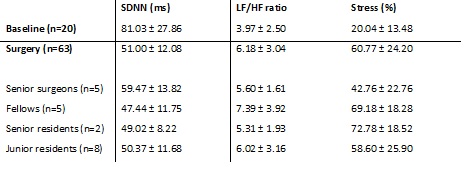M. Weenk1, A. P. Alken1, L. J. Engelen1, B. J. Bredie1, T. H. Van De Belt1, H. Van Goor1 1Radboudumc,Nijmegen, GELDERLAND, Netherlands
Introduction:
Surgery is a stressful profession. Stress may negatively affect surgeons’ performance in the operating room, jeopardizing patient safety. Studies reporting on stress in surgeons focused on perceived stress during operations. For measuring objective stress, complex methods (saliva cortisol level) are used that cannot record stress real time and for a longer period. Long lasting stress patterns during the day and outside the operating room, and the effect of demographics and surgical factors (e.g. experience) on stress are of interest to identify areas and individuals for stress modulation. This pilot study aimed at continuously measuring mental stress during common daily activities in surgeons and residents using a novel, easy to wear sensor.
Methods:
Surgeons and residents wore the HealthPatch™ (Vital Connect) continuously for 2 to 3 days including operations, outpatient clinics, ward visits, and other tasks such as administrative work. The wireless patch, that is attached to the chest skin without wires, is able to measure heart rate variability (HRV), and stress level in percentage using an algorithm of heart rate (HR) and HRV. The standard deviation of the interval between two heart beats (SDNN) and the ratio between low frequency and high frequency (LF/HF ratio) represented HRV and were automatically calculated by the patch. The patch stops measuring stress percentage during increased physical activity. Data was transmitted to the cloud by a smart phone and were downloaded for analysis. Subjective stress was measured before and after each operation using the State Trait Anxiety Inventory (STAI; ?STAI ≥1 point indicates increased stress).
Results:
Significant differences in SDNN, LF/HF ratio, and stress percentages were found in both surgeons and residents during operative procedures in comparison with baseline (p=.000; p=.01; p=.000). SDNN and stress percentage differed significantly between operations and outpatient clinic (p=.000 and p=.001), other work (p=.000 and p=.000), and ward visits (p=.006 and p=.000). Fellows and senior residents had higher stress percentages than senior surgeons during operations (p=.024 and p=.021). SDNN, LF/HF ratio, and stress percentage did not differ between surgical procedures indicated as stressful (?STAI≥1) or not stressful (?STAI<1).
Conclusion:
Continuous stress monitoring in surgeons and resident surgeons using a wearable sensor patch reveals relevant data on mental stress of surgeons and residents during the day. Performing an operation is mentally more stressful than other daily activities, particularly for residents and fellows. In future studies, the smart patch could be used for assessing the effect of stress on skills and during training programs.
